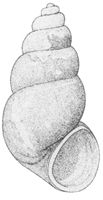The shells illustrated here lack their opercula.
Genus: HYDROBIA W. Hartmann, 1821
One species found in Britain; restricted to brackish-water. The British species of Peringia and Ventrosia were previously included in Hydrobia.

Hydrobia acuta
ssp. neglecta
Muus, 1963
Hydrobia acuta neglecta Muus, 1963
Description: The shell is intermediate between that of Peringia ulvae and that of Ventrosia ventrosa as regards the degree of swelling of the whorls, but narrower than both and with a blunt apex. The body whorl forms about two-thirds of the height of the shell, and the mouth 35 – 40%. The snout of the animal is bifid and has a dark transverse line as in Peringia ulvae, and dark lateral ones and (usually) a median one as well. The tentacles have a conical area of black pigment close to the tip.
Size: Height: 3 to 4 mm. Breadth: 2 mm.
Habitat: It occurs in permanently submerged (non-tidal) situations and prefers salinities intermediate between Ventrosia ventrosa and Peringia ulvae. It is not readily identified on shell characters, and it was previously confused with Ventrosia ventrosa. Care is needed in identification.
This species was previously considered to be a north-west European endemic, but Anderson (2008) puts the case for maintaining it as a subspecies only.

Ventrosia ventrosa
(Montagu, 1803)
Genus: Ventrosia Radoman, 1977
One species found in Britain; restricted to brackish-water.
Ventrosia ventrosa (Montagu, 1803)
Description: The shell is rather like that of Peringia ulvae, but with a more slender spire and markedly tumid whorls and deep sutures. There are 5 to 7 whorls. The aperture is rounded adapically, with its greatest breadth about the middle of its height. The body whorl forms 60 – 70% of the height of the shell, and the mouth 30 – 40%. The snout of the animal is bifid and is without an anterior dark transverse line, but has dark lateral lines which converge posteriorly behind the tentacles. There may be a dusky longitudinal line near the tip of each tentacle, but there are no dark transverse lines on the tentacles.
Size: Height: Up to 4.5 mm. Breadth: 2 mm.
Habitat: Prefers lower salinities than Peringia ulvae and more sheltered localities away from tidal movement. It tends to occur in drainage channels in coastal marshes and lagoons with little direct contact with the sea, living more or less permanently submerged.
The use of a separate genus is contenious here, but Wilke et al. (2000) has shown the existence of three distinct clades in European Hydrobia sensu lato, represented by the genera Hydrobia sensu stricto, Peringia and Ventrosia Radoman.
